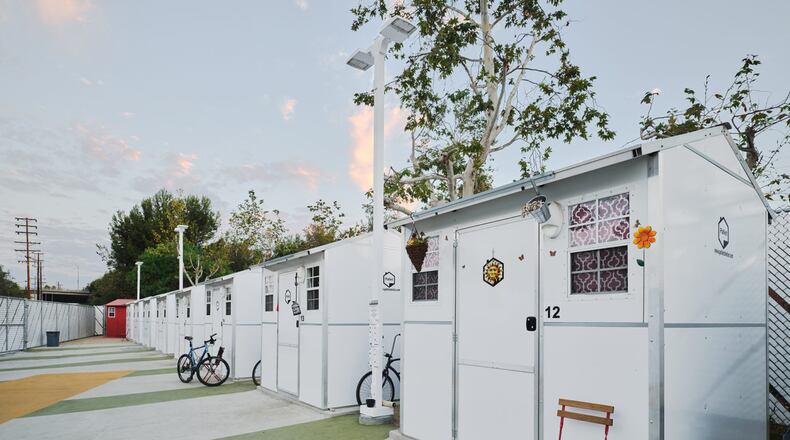Mindy Muller, chair of the Butler County Housing and Homeless Coalition, stressed the PIT results don’t paint “a true picture” of the county’s number of homeless. It would be impossible to accurately count the homeless because they are spread throughout the county and many don’t want to be found, she said.
Every winter the county physically counts the homeless so it can receive Department of Housing and Urban Development funding, she said. The point-in-time (PIT) counts were conducted last month, but those results haven’t been released, according to Muller.
She said Transitional Living oversees the overnight unsheltered count that’s done with local police officers.
The 306 doesn’t include people residing in the numerous homeless shelters, those “couch surfing” with friends and those living in extended stay hotels.
Regardless of the number of homeless, city and county leaders continue working toward reducing the homeless population in their communities, and a lot of times, that means investing millions of dollars.
The exact amount of money spent on homelessness in the county would be impossible to calculate because of all the financial streams, including donations from churches, food pantries and other agencies and organizations, Muller said
The goal, they say, is to figure out the best way to determine why a person is homeless, provide them the necessary addiction and mental illness treatment options, get them into transitional housing, and find them employment so they can become productive citizens.
But all of that takes money.
Butler County communities have millions of dollars available from American Rescue Plan Act (ARPA) funds, some of it earmarked to address homeless issues.
Middletown, the second largest city in the county, appears to be the most aggressive in fighting homelessness.
The city paid nearly $50,000 last year to hire unarmed security guards to patrol the downtown after continuous complaints from business owners; awarded a $90,000 grant to open a warming center for three months during the winter; and is considering purchasing portable pallet homes and supportive equipment and utilities estimated to cost about $900,000.
City Manager Jim Palenick, when making a presentation at the recent City Council Strategic Planning Meeting, called homelessness “such a tough topic.” He has worked extensively on the issue during his two years as city manager.
Middletown also is home to the largest — and most expensive — homeless shelter in the area.
The Hope House Mission men’s shelter, 1001 Grove St., cost $11.4 million and opened in 2020, said Tim Williams, executive director of operations.
The facility replaced the 150-year-old former U.S. Hotel on Main Street and it includes a 50-bed emergency shelter for men and 30 one-bedroom apartments for the chronically homeless, he said.
Despite all the services at Hope House and the funding from the city and county, Williams said homelessness never will disappear. Some people just prefer to be homeless, he said.
“Because of mental health and addictions, some don’t want to come in,” he said. “There’s still an element of people who want to live out on their own.”
Hope House, a subsidiary of City Gospel Mission, which has been based in Cincinnati since 1924. had a budget of $850,000 last year, Williams said. He said that’s “a good amount” of money, but the key is spending it wisely.
The goal is to get everybody in “a better place than before and to lift up the lower end of the population to help your city be more attractive,” Williams said.
For those living at Hope House, the leaders want the residents to take “baby steps,” Williams said. That means getting them into treatment if necessary, examining the “root issues” of why they’re homeless, and teaching them to take better care of themselves mentally and physically.
“Create a brand new life,” he said.
Butler County homeless shelters have seen a larger demand for services after Serving Homeless Alternate Lodging Of Middletown (SHALOM), a church-based shelter, closed two years ago due to COVID-19 concerns.
Bill Fugate, volunteer coordinator, said SHALOM doesn’t receive any city or county financial support. It’s driven totally by private and church donations.
“Money is not the driving force for SHALOM,” he said. “We are there to serve. Some of us pay out of our own pockets. That’s unusual.”
Every Monday, Wednesday and Saturday, SHALOM volunteers prepare and serve breakfast from 8:30 a.m. to 9:30 a.m. in the parking lot of First United Methodist Church, 120 S. Broad St.
Kathy Becker, director of law enforcement and criminal justice for Access Counseling, who has spent her life helping the homeless, said while “peoples’ hearts are in the right place” it will take more than money to reduce the homeless population. Those who work with the homeless need to gain their confidence and get to know them individually, she said.
That personal relationship may be more valuable than any federal funds, she said.
“Money may not be the total answer,” Becker said. “I hate to see us throw money at the problem until we know what will work.”
Muller said more money should be invested in prevention. It would be more effective working with individuals who are at risk for becoming homeless before they end up on the streets, she said.
Prevention measure are “highly successful,” she said.
David Hood, hired two years ago to serve as executive director of Serve City in Hamilton, said his $750,000 annual budget is divided equally between federal and state grants and private donations/proceeds from its transitional living apartments.
Serve City has 12, two-bedroom apartments with an occupancy of 48 residents and 26 efficiency, one-bedroom apartments.
For homeless shelters like Serve City, the “tricky part” will be operating at the same level once the one-time ARPA grants expire.
Homeless shelters can’t spend their way out of the issues that face their clients, he said.
“There will always be some level of homelessness,” Hood said. “For some, it’s a lifestyle choice and for many, many more, homelessness is a result of mental illness, generational poverty and addictions.”
Credit: Nick Graham
Credit: Nick Graham
SOME OF THE MONEY SPENT ON HOMELESS SERVICES IN BUTLER COUNTY IN 2021
Hope House Men’s Shelter, Middletown: $850,000
Serve City, Hamilton: $750,000
Middletown Warming Center for three months: $90,000
Downtown Middletown security for six months: $49,724
SOURCE: Homeless shelter executives, city officials
About the Author


